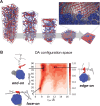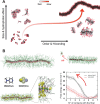The Martini Model in Materials Science
- PMID: 33956373
- PMCID: PMC11468591
- DOI: 10.1002/adma.202008635
The Martini Model in Materials Science
Abstract
The Martini model, a coarse-grained force field initially developed with biomolecular simulations in mind, has found an increasing number of applications in the field of soft materials science. The model's underlying building block principle does not pose restrictions on its application beyond biomolecular systems. Here, the main applications to date of the Martini model in materials science are highlighted, and a perspective for the future developments in this field is given, particularly in light of recent developments such as the new version of the model, Martini 3.
Keywords: Martini; coarse-graining; molecular dynamics.
© 2021 The Authors. Advanced Materials published by Wiley-VCH GmbH.
Conflict of interest statement
The authors declare no conflict of interest.
Figures










References
-
- Takada S., Kanada R., Tan C., Terakawa T., Li W., Kenzaki H., Acc. Chem. Res 2015, 48, 3026. - PubMed
-
- Joshi S. Y., Deshmukh S. A., Mol. Simul. 2020, 10.1080/08927022.2020.1828583. - DOI
-
- Marrink S. J., Risselada H. J., Yefimov S., Tieleman D. P., de Vries A. H., J. Phys. Chem. B 2007, 111, 7812. - PubMed
-
- Marrink S. J., de Vries A. H., Mark A. E., J. Phys. Chem. B 2004, 108, 750.
LinkOut - more resources
Full Text Sources
Other Literature Sources

